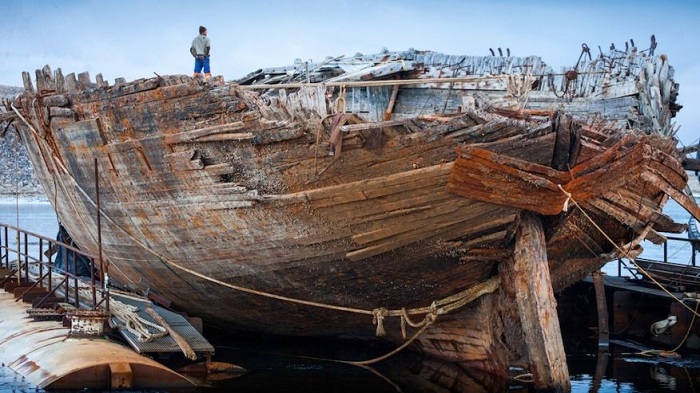80 years later, polar explorer`s sunken ship floats again

This past summer, a Norwegian salvage expedition says they successfully raised the wreck onto a barge.
The Maud is "ready for the next step, which is to sail home," project manager Jan Wanggaard told Live Science.
Amundsen was the first person to reach the South Pole and the first to lead an expedition through the Northwest Passage from the northern. When the Maud was built, Amundsen`s goal was to sail through the unexplored part of the Arctic Ocean, and perhaps drift over to the North Pole.
From 1918 to 1920, Amundsen and his crew sailed from Oslo, Norway, along the Russian Arctic coast to Nome, Alaska, traversing a Northeast Passage. Amundsen eventually abandoned the plan to go to the North Pole. Maud spent a total of seven years exploring the Arctic before the ship was seized by Amundsen`s creditors and was sold to Canada`s Hudson`s Bay Co., according to Norway’s Fram Museum.
Although the Maud`s exploits aren`t widely known today, the expedition was quite eventful for Amundsen—he was nearly mauled to death by a polar bear and poisoned by carbon monoxide. It also resulted in heaps of scientific data on the Arctic environment.
Amundsen`s scientific director aboard the Maud was Harald Sverdrup, an accomplished oceanographer who later became director of the Scripps Institution of Oceanography in San Diego. His team recorded magnetic, astronomical and meteorological observations. They took photos of the northern lights. Sverdrup even spent seven months among the Chukchi people in northeastern Russia and took ethnographic notes about the tribe`s language and customs.
A leak caused by the propeller axle sunk the Maud in 1930. Over the following years, some of the ship`s timber was salvaged for fuel. Norway took back ownership of the Maud in the 1990s. After a long stretch of legal and logistical hurdles, a Norwegian salvage team finally got the go-ahead to raise the Maud and bring it back to a custom-made museum in Vollen, Norway, according to Norway’s Fram Museum.
Wanggaard said he had explored the Maud many times during diving expeditions but that he was still struck by the size of the ship when it was raised. His team had to use about 50 air bags, each with 4 tons of lifting power, to raise the Maud off the seafloor and scoop the ship onto a barge.
"You cannot grasp the whole image of the ship underwater," Wanggaard said. "When it came up, it was bigger than we could imagine."
The Maud had to be cleared of the mud and sediment that had built up inside, and Wanggaard said the team has found a lot of technical parts, blocks for sails, firewood, coal and other artifacts. "It`s in very good condition," Wanggaard told Live Science. "It just needs to dry. That`s a long process, but it`s good to be here. It`s best to dry in low temperatures. It`s like a freeze-drying process."
Right now, the barge the Maud sits on is frozen in place, and Wanggaard will spend the upcoming winter plotting the ship`s journey back to Norway. The expected sailing time is one month, he said, but timing the expedition is a tricky matter.
The team might have to wait until July or August for the sea ice to dissipate so that they can safely leave Cambridge Bay. And the Arctic sea ice could start freezing up again before the Maud makes it home, meaning the team would have to spend another winter at a pit stop in Greenland or northern Russia. Wanggaard said he also has to decide whether to take an easterly route to reach Norway or head westward back over Amundsen`s Northeast Passage.















































